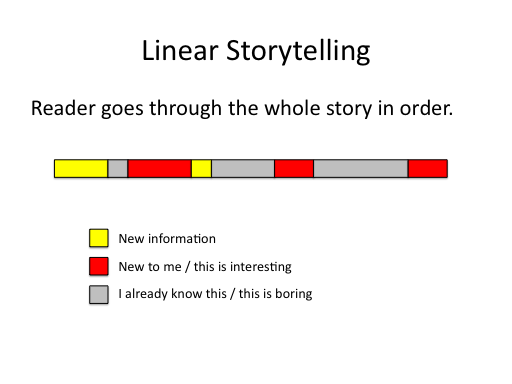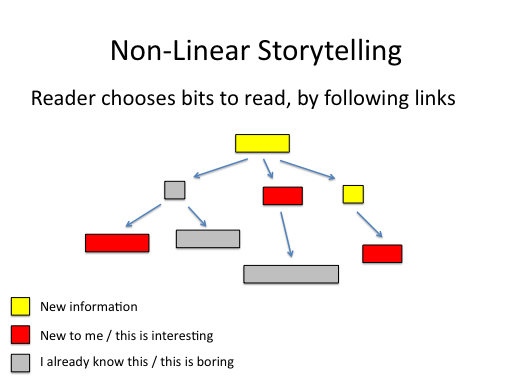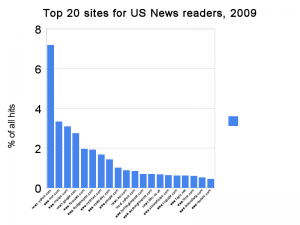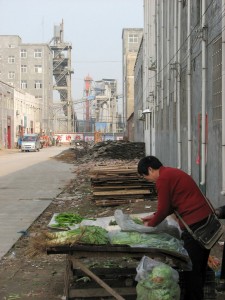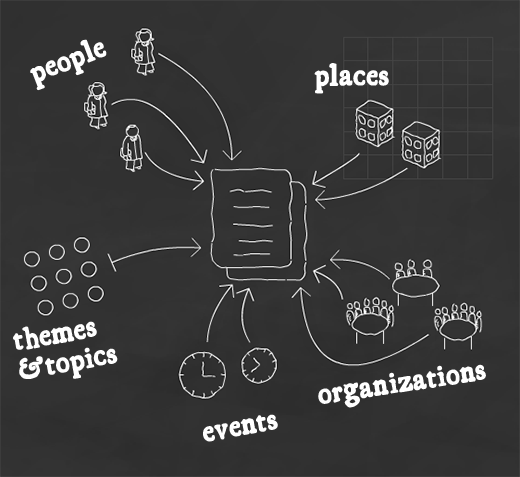According to Facebook, social news seems to be mostly about knowing what all my friends are reading. I’m not so sure. But I think there really is something to the idea of “social news” for journalism, and for journalism product design.
I take “social” to mean “interacting with other people.” That’s a fundamental technical possibility of digital media, as basic to the internet as moving pictures are to television. I’m not sure that anyone really knows yet what to do with that possibility, but happily there are already at least two very well-developed uses. Maybe social news isn’t about “friends” at all, but about filtering and news-gathering.
Twitter is really a filter
I get most of both my general and special interest news from Twitter. I rarely go to the home page of a news site, or use a news app. It’s not the tweets themselves that are informative, but the links within them to articles posted elsewhere. I follow a large set of people with varied interests, and some of them work for news organizations, but most do not. My twitter feed is faster, more diverse, and available across more platforms (all of them) than any one news organization’s output.
This doesn’t mean that Twitter is a perfect news delivery system, but to me it’s proven better than just about anything else at getting me the news mix that I want, and keeping me interested in the world at large. (Admittedly, I follow people I’ve met in other countries, so yeah, travel is way better than Twitter for that.) I am not alone in this opinion. The structure of follower relationships among Twitter users suggests that it’s more of a news network than a social network.
The usefulness of Twitter for news has a lot to do with certain basic design choices. First, a tweet is really as short as you can get and still communicate a complete concept, so it’s basically an extended headline. Second, Twitter differs from Facebook in that relationships can be unidirectional: I don’t need anyone’s permission to follow them, and they may not know or care that I do. Following someone on Twitter also differs from following a blog via RSS because most tweets refer to someone else’s work through a link — Twitter is more about re-publishing than publishing. Retweets also include the name of the original tweeter, which enables discovery of interesting new curators.
Filtering is much more valuable than it used to be, in this era of information overload, and these properties make Twitter an excellent filtering system. There are several news products based almost entirely on displaying links tweeted by the people you follow, such as The Twitter Tim.es and Flipboard. The medium that Twitter invented — global public short messaging with links — has already been endlessly replicated and will be with us forever.
There is a sense in which news organizations have always seen filtering as a big part of their value. One of the duties of the professional editor is to decide what you need to see. But at least one thing has upset that model irretrievably: the internet is not a broadcast medium. While each person reads an identical copy of the Times and watches an identical CNN broadcast, there’s no reason my internet has to look the same as your internet. A small team of human editors can’t personalize the headlines for every reader, so that leaves algorithmic filtering, such as Google News’ personalization features, or social filtering, such as Twitter.
The point is, there’s probably something to learn from how Twitter uses social relationships to route information. As the Nieman Journalism Lab said: “social news isn’t about the people you know so much as the people with whom you share interests.” To put this in terms of the product I wish I had: when I use your news product, I want to be able to follow the recommended reading of other members of the audience, if they so allow. Also, can I follow a particular reporter? And does your product integrate with the other methods I already use for getting information, so I don’t have to choose?
Social networks are great for reporting
Audience-journalist collaboration, blah blah blah. If the idea that professionals are no longer the only players in news is new to you, see blogging and Wikipedia. But a news organization probably has to look at this from a different angle. For me, the core idea of social news-gathering is that the audience is, or could be, an extension of the news organization’s source network.
Hopefully, a newsroom knows about interesting developments before anyone else, and then verifies and publicizes them, but that’s getting near impossible when anyone can publish, and when virality can amplify primary sources without the involvement of a media organization. We don’t know yet very much about collective news-gathering, but there are promising directions. It seems like maybe there are two broad categories of breaking news: public events that anyone could have witnessed, and private events initially known only to privileged observers.
Social media is now routinely used to augment reporting of public events. There are entire units in news organizations dedicated to getting stories from the audience, often under the awkward rubric of “user-generated content.” But why sift for events online when you can give your audience the tools to give you the story directly? Right now if I see a plane land in a river, I tweet it. Wouldn’t a news organization prefer that I send my eye-witness photo to the UGC editor instead? To this end, several mobile news apps include the ability to submit pictures. CNN’s iReport app and website is probably the best developed of these. Ideally, I could send that breaking news tweet to the newsroom and to my friends at the same time, within the same application.
Fast reporting of private events has always depended on having the right sources. A well established source may call the reporter or send an email when something newsworthy happens. Someone with a much looser connection to the organization may not, and perhaps this is an opportunity for social news tools. When someone knows something — or can talk about something — you want them to contact the newsroom first. The potential of this weak-tie news sourcing approach hasn’t really been studied, to my knowledge, but I imagine that it would require, at minimum, a trusted brand, an easily-reachable editorial staff, and frictionless communication tools. If it’s easier just to tweet or blog the news, the source will.
There are several other good examples of social news-gathering, on the theme of asking your audience for help. Crowdsourcing is usually thought of as the recruitment of many unspecialized helpers, as the Guardian did with its MP expenses project. But the Guardian also reached out to its audience to find that one specialist attorney who could unravel the mystery of Tony Blair’s tax returns. Hopefully the specialists a newsroom needs to consult are already among the audience, and they will see the call for experts when a reporter sends one out. For that matter, a smart and engaged audience can correct you quickly when you are wrong. Nothing says “we care about accuracy” like a fact check box on every story.
But is it journalism?
Yes, absolutely. The job of journalism is to collect accurate information on an ongoing basis and ensure that the audience for each story learns about that story. Any way you can deliver that service is fair game. People depend on each other for the news all the time, so journalists better get in those conversations.

